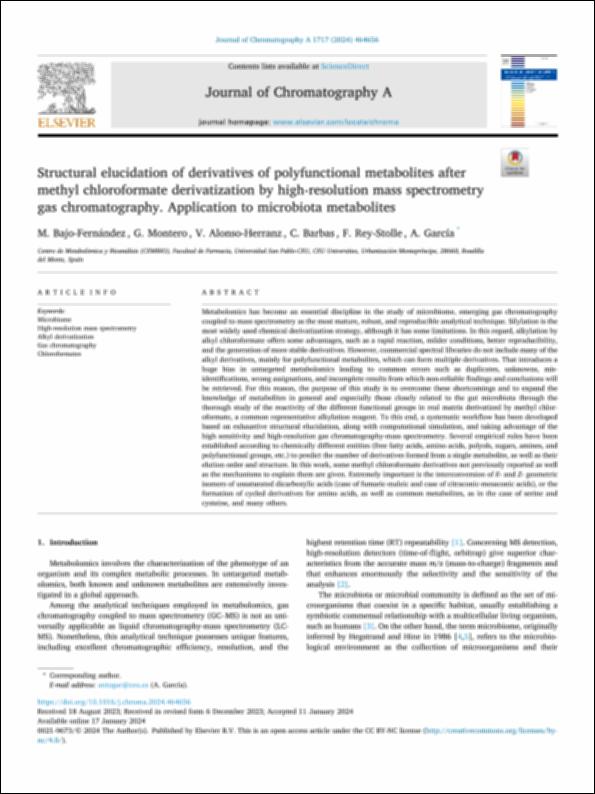Por favor, use este identificador para citar o enlazar este ítem:
http://hdl.handle.net/10637/15733Structural elucidation of derivatives of polyfunctional metabolites after methyl chloroformate derivatization by high-resolution mass spectrometry gas chromatography. Application to microbiota metabolites
| Título : | Structural elucidation of derivatives of polyfunctional metabolites after methyl chloroformate derivatization by high-resolution mass spectrometry gas chromatography. Application to microbiota metabolites |
| Autor : | Bajo Fernández, María Montero, G. Alonso Herranz, Vanesa Barbas Arribas, Coral. Rey-Stolle, María Fernanda García Fernández, Antonia |
| Materias: | Microbiome; High-resolution mass spectrometry; Gas chromatography; Chloroformates |
| Editorial : | Elsevier |
| Citación : | M. Bajo-Fernández, G. Montero, V. Alonso-Herranz, C. Barbas, F. Rey-Stolle, A. García, Structural elucidation of derivatives of polyfunctional metabolites after methyl chloroformate derivatization by high-resolution mass spectrometry gas chromatography. Application to microbiota metabolites, Journal of Chromatography A, Volume 1717, 2024, 464656, ISSN 0021-9673, https://doi.org/10.1016/j.chroma.2024.464656 |
| Resumen : | Metabolomics has become an essential discipline in the study of microbiome, emerging gas chromatography coupled to mass spectrometry as the most mature, robust, and reproducible analytical technique. Silylation is the most widely used chemical derivatization strategy, although it has some limitations. In this regard, alkylation by alkyl chloroformate offers some advantages, such as a rapid reaction, milder conditions, better reproducibility, and the generation of more stable derivatives. However, commercial spectral libraries do not include many of the alkyl derivatives, mainly for polyfunctional metabolites, which can form multiple derivatives. That introduces a huge bias in untargeted metabolomics leading to common errors such as duplicates, unknowns, misidentifications, wrong assignations, and incomplete results from which non-reliable findings and conclusions will be retrieved. For this reason, the purpose of this study is to overcome these shortcomings and to expand the knowledge of metabolites in general and especially those closely related to the gut microbiota through the thorough study of the reactivity of the different functional groups in real matrix derivatized by methyl chloroformate, a common representative alkylation reagent. To this end, a systematic workflow has been developed based on exhaustive structural elucidation, along with computational simulation, and taking advantage of the high sensitivity and high-resolution gas chromatography-mass spectrometry. Several empirical rules have been established according to chemically different entities (free fatty acids, amino acids, polyols, sugars, amines, and polyfunctional groups, etc.) to predict the number of derivatives formed from a single metabolite, as well as their elution order and structure. In this work, some methyl chloroformate derivatives not previously reported as well as the mechanisms to explain them are given. Extremely important is the interconversion of E- and Z- geometric isomers of unsaturated dicarboxylic acids (case of fumaric-maleic and case of citraconic-mesaconic acids), or the formation of cycled derivatives for amino acids, as well as common metabolites, as in the case of serine and cysteine, and many others. |
| URI : | http://hdl.handle.net/10637/15733 |
| Derechos: | http://creativecommons.org/licenses/by-nc/4.0/deed.es Open Access |
| ISSN : | 1873-3778 |
| Cubierto por: | Acuerdo Transformativo - 2024 |
| Fecha de publicación : | 17-ene-2024 |
| Centro : | Universidad San Pablo-CEU |
| Aparece en las colecciones: | Facultad de Farmacia |
Los ítems de DSpace están protegidos por copyright, con todos los derechos reservados, a menos que se indique lo contrario.


